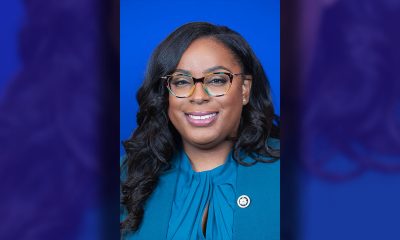Politics
How Obama Reversed Course on Federal College Ratings

President Barack Obama speaks at the University of Wisconsin at La Crosse, in La Crosse, Wis., Thursday, July 2, 2015, about the economy and to promote a proposed Labor Department rule that would make more workers eligible for overtime. (AP Photo/Morry Gash)
JOSH LEDERMAN, Associated Press
WASHINGTON (AP) — President Barack Obama dearly wanted to get the government in the business of rating colleges and universities based on value and affordability, promising a new system by 2015. Now that goal is shriveling under the weight of a concerted opposition from universities, lawmakers and bureaucrats in Obama’s own administration.
Nearly two years after the president, standing before a crowd of 7,000 at the University at Buffalo, unveiled the bold proposal as a way to curb soaring college costs, his administration has quietly but drastically scaled back the initiative. No longer does the federal government intend to use a formula to score schools based on factors like price, average student debt and graduation rates, as Obama had envisioned.
Instead, the new tool will allow prospective students to decide which factors are important to them, then draw their own conclusions from the statistics. But the Education Department declined to say which new statistics the tool will offer that aren’t already available on existing government websites.
Abandoning the original plan marked the latest in a series of stumbles for Obama’s education priorities. In his 2013 State of the Union address, Obama called for expanding access to pre-kindergarten to all American children, and in his 2015 address, he pushed a $60 billion plan to offer two years of free community college. Neither proposal has gained any traction.
The Education Department said it’s still determining what the revised college tool will look like, but that it’s still on track to roll it out by the start of the 2015-2016 academic year, roughly two months from now.
“It is anything but a retreat,” Education Department Undersecretary Ted Mitchell said in an interview. “It’s a retooling and, we think, an advance on the original concept.”
Yet Obama’s goal, as he described when he announced the plan in August 2013, was to create an alternative to private rankings like U.S. News and World Report whose formulas incentivize schools to “game the numbers” and even raise costs. Instead, Obama sought a system that prioritized whether schools are enrolling and graduating poorer students and whether their graduates succeed in the workforce.
“I think we should rate colleges based on opportunity — are they helping students from all kinds of backgrounds succeed — and on outcomes, on their value to students and parents,” Obama said. He took it a step further by proposing that Congress eventually tie a school’s eligibility for federal financial aid to its score in the new ratings system.
Resistance to Obama’s plan was swift, vehement and nearly universal.
Associations representing colleges with traditionally conflicting interests — such as community colleges and private universities — all lined up in opposition, warning the project was too complex, too subjective and too dependent on shoddy data to ever work fairly. As the Education Department mounted an extensive, lengthy listening tour across the country, college presidents warned of dire unintended consequences and implored the government to reconsider.
On Capitol Hill, the proposal drew pushback not only from the president’s traditional Republican foes, but also some Democrats. Sen. Lamar Alexander, R-Tenn., a former education secretary and chair of the Senate’s education panel, took to the Senate floor to threaten an amendment blocking the ratings system. And in the House, Republican Rep. Bob Goodlatte of Virginia and Democratic Rep. Michael Capuano of Massachusetts — two states with large numbers of colleges — joined forces to sponsor a resolution opposing Obama’s plan.
“Do I think they would have continued if no one had pushed back? Of course I do,” Capuano said.
But for nearly two years, the administration stuck to the original plan. In a blog post in December 2014, the Education Department said it was considering rating schools as high-performing, medium-performing or low-performing and outlined a few potential metrics, but disappointed many by failing to flesh out the formula it would use to assign ratings.
Driving the decision to stick with a ratings system was Obama, who was dead-set on carrying out his original vision for the project, according to interviews with nearly a dozen congressional aides, administration officials and college association leaders. Many of them spoke on condition of anonymity to avoid criticizing the president publicly.
From the start, career bureaucrats and data experts at the Education Department said the idea wasn’t feasible, but met continued White House resistance, those officials said. Technical experts in the education industry that the administration consulted offered similar warnings. Eventually, higher-level Education Department officials grew convinced the plan was unworkable, and persuaded the White House to allow a scaled-back approach devoid of hard-and-fast ratings.
“We are right where the president wanted us to be in terms of making progress toward his vision,” said James Kvaal, deputy director of the White House’s Domestic Policy Council.
University associations that had fought the proposal praised the Obama administration for taking their concerns seriously and eventually agreeing to abandon the initial plan, calling it a rare example of the government acknowledging its own missteps.
“They really did listen on this,” said Sarah Flanagan, the top lobbyist for the National Association of Independent Colleges and Universities. “The more they looked into it, they realized it wasn’t doable.”
___
Reach Josh Lederman on Twitter at http://twitter.com/joshledermanAP
Copyright 2015 The Associated Press. All rights reserved. This material may not be published, broadcast, rewritten or redistributed.
Alameda County
Oakland Council Expands Citywide Security Cameras Despite Major Opposition
In a 7-1 vote in favor of the contract, with only District 3 Councilmember Carroll Fife voting no, the Council agreed to maintain its existing network of 291 cameras and add 40 new “pan-tilt-zoom cameras.”

By Post Staff
The Oakland City Council this week approved a $2.25 million contract with Flock Safety for a mass surveillance network of hundreds of security cameras to track vehicles in the city.
In a 7-1 vote in favor of the contract, with only District 3 Councilmember Carroll Fife voting no, the Council agreed to maintain its existing network of 291 cameras and add 40 new “pan-tilt-zoom cameras.”
In recent weeks hundreds of local residents have spoken against the camera system, raising concerns that data will be shared with immigration authorities and other federal agencies at a time when mass surveillance is growing across the country with little regard for individual rights.
The Flock network, supported by the Oakland Police Department, has the backing of residents and councilmembers who see it as an important tool to protect public safety.
“This system makes the Department more efficient as it allows for information related to disruptive/violent criminal activities to be captured … and allows for precise and focused enforcement,” OPD wrote in its proposal to City Council.
According to OPD, police made 232 arrests using data from Flock cameras between July 2024 and November of this year.
Based on the data, police say they recovered 68 guns, and utilizing the countywide system, they have found 1,100 stolen vehicles.
However, Flock’s cameras cast a wide net. The company’s cameras in Oakland last month captured license plate numbers and other information from about 1.4 million vehicles.
Speaking at Tuesday’s Council meeting, Fife was critical of her colleagues for signing a contract with a company that has been in the national spotlight for sharing data with federal agencies.
Flock’s cameras – which are automated license plate readers – have been used in tracking people who have had abortions, monitoring protesters, and aiding in deportation roundups.
“I don’t know how we get up and have several press conferences talking about how we are supportive of a sanctuary city status but then use a vendor that has been shown to have a direct relationship with (the U.S.) Border Control,” she said. “It doesn’t make sense to me.”
Several councilmembers who voted in favor of the contract said they supported the deal as long as some safeguards were written into the Council’s resolution.
“We’re not aiming for perfection,” said District 1 Councilmember Zac Unger. “This is not Orwellian facial recognition technology — that’s prohibited in Oakland. The road forward here is to add as many amendments as we can.”
Amendments passed by the Council prohibit OPD from sharing camera data with any other agencies for the purpose of “criminalizing reproductive or gender affirming healthcare” or for federal immigration enforcement. California state law also prohibits the sharing of license plate reader data with the federal government, and because Oakland’s sanctuary city status, OPD is not allowed to cooperate with immigration authorities.
A former member of Oakland’s Privacy Advisory Commission has sued OPD, alleging that it has violated its own rules around data sharing.
So far, OPD has shared Flock data with 50 other law enforcement agencies.
Activism
Families Across the U.S. Are Facing an ‘Affordability Crisis,’ Says United Way Bay Area
United Way’s Real Cost Measure data reveals that 27% of Bay Area households – more than 1 in 4 families – cannot afford essentials such as food, housing, childcare, transportation, and healthcare. A family of four needs $136,872 annually to cover these basic necessities, while two adults working full time at minimum wage earn only $69,326.

By Post Staff
A national poll released this week by Marist shows that 61% of Americans say the economy is not working well for them, while 70% report that their local area is not affordable. This marks the highest share of respondents expressing concern since the question was first asked in 2011.
According to United Way Bay Area (UWBA), the data underscores a growing reality in the region: more than 600,000 Bay Area households are working hard yet still cannot afford their basic needs.
Nationally, the Marist Poll found that rising prices are the top economic concern for 45% of Americans, followed by housing costs at 18%. In the Bay Area, however, that equation is reversed. Housing costs are the dominant driver of the affordability crisis.
United Way’s Real Cost Measure data reveals that 27% of Bay Area households – more than 1 in 4 families – cannot afford essentials such as food, housing, childcare, transportation, and healthcare. A family of four needs $136,872 annually to cover these basic necessities, while two adults working full time at minimum wage earn only $69,326.
“The national numbers confirm what we’re seeing every day through our 211 helpline and in communities across the region,” said Keisha Browder, CEO of United Way Bay Area. “People are working hard, but their paychecks simply aren’t keeping pace with the cost of living. This isn’t about individual failure; it’s about policy choices that leave too many of our neighbors one missed paycheck away from crisis.”
The Bay Area’s affordability crisis is particularly defined by extreme housing costs:
- Housing remains the No. 1 reason residents call UWBA’s 211 helpline, accounting for 49% of calls this year.
- Nearly 4 in 10 Bay Area households (35%) spend at least 30% of their income on housing, a level widely considered financially dangerous.
- Forty percent of households with children under age 6 fall below the Real Cost Measure.
- The impact is disproportionate: 49% of Latino households and 41% of Black households struggle to meet basic needs, compared to 15% of white households.
At the national level, the issue of affordability has also become a political flashpoint. In late 2025, President Donald Trump has increasingly referred to “affordability” as a “Democrat hoax” or “con job.” While he previously described himself as the “affordability president,” his recent messaging frames the term as a political tactic used by Democrats to assign blame for high prices.
The president has defended his administration by pointing to predecessors and asserting that prices are declining. However, many Americans remain unconvinced. The Marist Poll shows that 57% of respondents disapprove of Trump’s handling of the economy, while just 36% approve – his lowest approval rating on the issue across both terms in office.
Activism
Black Arts Movement Business District Named New Cultural District in California
Located in the heart of District 3, the BAMBD is widely regarded as one of the nation’s most important centers of Black cultural production — a space where artists, entrepreneurs, organizers, and cultural workers have shaped generations of local and national identity. The state’s recognition affirms the district’s historic importance and its future promise.

By Post Staff
Oakland’s Black Arts Movement Business District (BAMBD) has been selected as one of California’s 10 new state-designated Cultural Districts, a distinction awarded by the California Arts Council (CAC), according to a media statement released by Councilmember Carroll Fife.
The BAMBD now joins 23 other districts across the state recognized for their deep cultural legacy, artistic excellence, and contributions to California’s creative economy.
Located in the heart of District 3, the BAMBD is widely regarded as one of the nation’s most important centers of Black cultural production — a space where artists, entrepreneurs, organizers, and cultural workers have shaped generations of local and national identity. The state’s recognition affirms the district’s historic importance and its future promise.
“This designation is a testament to what Black Oakland has built — and what we continue to build when we insist on investing in our own cultural and economic power,” said Fife.
“For years, our community has fought for meaningful recognition and resources for the Black Arts Movement Business District,” she said. “This announcement validates that work and ensures that BAMBD receives the support it needs to grow, thrive, and continue shaping the cultural fabric of California.”
Since taking office, Fife has led and supported multiple initiatives that strengthened the groundwork for this achievement, including:
- Restoring and protecting arts and cultural staffing within the City of Oakland.
- Creating the West Oakland Community Fund to reinvest in historically excluded communities
- Advancing a Black New Deal study to expand economic opportunity for Black Oakland
- Ensuring racial equity impact analyses for development proposals, improving access for Black businesses and Black contractors
- Introduced legislation and budget amendments that formalized, protected, and expanded the BAMBD
“These efforts weren’t abstract,” Fife said. “They were intentional, coordinated, and rooted in a belief that Black arts and Black businesses deserve deep, sustained public investment.”
As part of the Cultural District designation, BAMBD will receive:
- $10,000 over two years
- Dedicated technical assistance
- Statewide marketing and branding support
- Official designation from Jan. 1, 2026, through Dec. 31, 2030
This support will elevate the visibility of BAMBD’s artists, cultural organizations, small businesses, and legacy institutions, while helping attract new investment to the district.
“The BAMBD has always been more than a district,” Fife continued. “This recognition by the State of California gives us another tool in the fight to preserve Black culture, build Black economic power, and protect the families and institutions that make Oakland strong.”
For questions, contact Councilmember Carroll Fife at CFife@oaklandca.gov.
-

 Activism4 weeks ago
Activism4 weeks agoOakland Post: Week of November 19 – 25, 2025
-

 #NNPA BlackPress3 weeks ago
#NNPA BlackPress3 weeks agoLIHEAP Funds Released After Weeks of Delay as States and the District Rush to Protect Households from the Cold
-

 Alameda County3 weeks ago
Alameda County3 weeks agoSeth Curry Makes Impressive Debut with the Golden State Warriors
-

 Activism4 weeks ago
Activism4 weeks agoOakland Post: Week of November 26 – December 2, 2025
-

 #NNPA BlackPress3 weeks ago
#NNPA BlackPress3 weeks agoSeven Steps to Help Your Child Build Meaningful Connections
-

 #NNPA BlackPress4 weeks ago
#NNPA BlackPress4 weeks agoBeyoncé and Jay-Z make rare public appearance with Lewis Hamilton at Las Vegas Grand Prix
-

 #NNPA BlackPress3 weeks ago
#NNPA BlackPress3 weeks agoSeven Steps to Help Your Child Build Meaningful Connections
-

 #NNPA BlackPress3 weeks ago
#NNPA BlackPress3 weeks agoTrinidad and Tobago – Prime Minister Confirms U.S. Marines Working on Tobago Radar System

















































